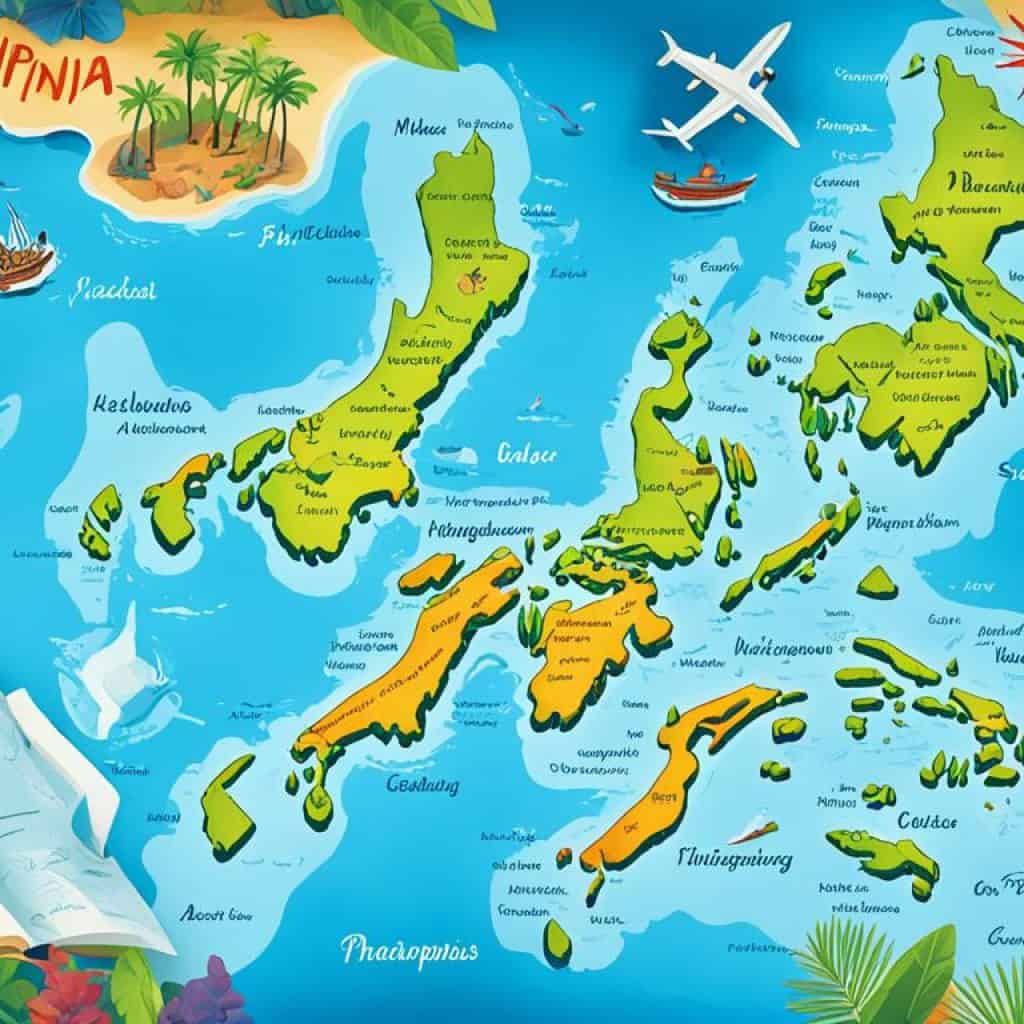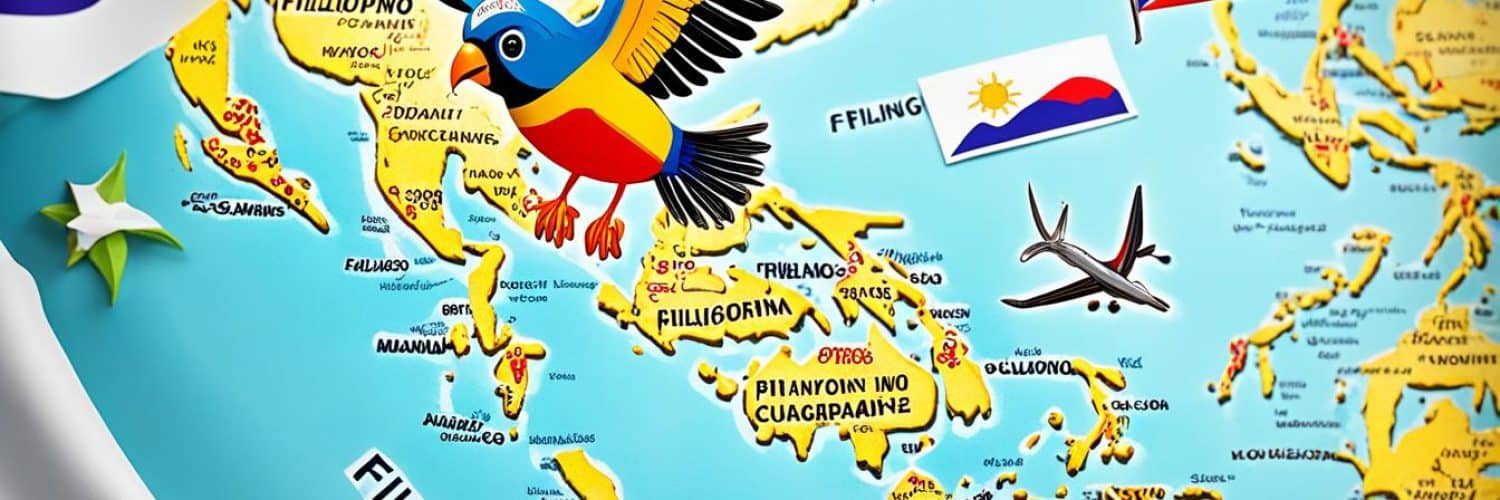Ever curious about the many languages spoken in the Philippines? Wonder what the national language is and its connection to Tagalog? Let’s go on a journey to learn about the Philippines’ language history, its variety, and the rich culture within its dialects.
Key Takeaways:
- The national language of the Philippines is Filipino, based on the standardized variety of Tagalog.
- The Philippines is a linguistically diverse country with over 175 living languages.
- Tagalog, one of the major languages in the Philippines, has its origins in the endonym “taga-ilog.”
- Spanish and English have influenced the linguistic landscape of the Philippines through colonization.
- Efforts are being made to preserve indigenous languages and promote multilingual education in the country.
The Linguistic Diversity of the Philippines
The Philippines stands out for its incredible linguistic diversity. It boasts over 170 languages across its islands. Filipino is the national language, but many indigenous languages thrive as well. These languages reflect the Philippines’ rich history of colonization and cultural mingling.
Major languages like Cebuano, Ilocano, Hiligaynon, and Bicolano add to the country’s rich linguistic mix. Each language is unique, showing the heritage and traditions of its speakers.
“The linguistic diversity of the Philippines is a testament to the country’s vibrant multicultural heritage. It highlights the deep connection between language and identity, showcasing the incredible richness of Filipino culture.”
The languages of the Philippines have changed over centuries, shaped by history and culture. Spanish and American colonization have mixed foreign words into Filipino and other local languages. This has made the languages even richer.
Indigenous Languages of the Philippines
Indigenous languages are key to the identity of various Filipino ethnic groups. They carry ancient traditions but face endangerment due to Filipino and English becoming more dominant.
The Philippines is fighting to keep its language diversity alive. Projects and programs are in place to protect endangered languages and encourage their use.
Language Diversity and Cultural Heritage
The Philippines’ cultural heritage is closely linked to its linguistic diversity. Language is how cultural practices, stories, and beliefs are expressed. It’s vital for preserving cultural identities.
Art forms like literature and music are deeply connected to native languages. They help keep traditions alive and celebrate the Philippines’ unique heritage.
Globalization poses a threat to these languages, yet the Philippines remains hopeful. With efforts in language revival and community involvement, the country aims to celebrate and protect its diverse languages and culture.
The Origins of Tagalog
Tagalog is spoken by the ethnic Tagalog people in the Philippines. It is related to other Philippine languages like Bikol and Bisayan. The name Tagalog possibly comes from “river dweller.” This language has a rich history. It comes from old languages and has borrowed words from Spanish and English.
Tagalog shapes the identity of Filipinos. It shows how different Philippine languages share a common heritage. The language’s growth tells us about the power of diverse cultural influences over time.
“The history of Tagalog showcases the rich linguistic tapestry of the Philippines. From its Proto-Philippine roots to its modern-day usage, Tagalog has played a significant role in shaping the language and cultural identity of the Filipino people.” – Linguistics expert
Ancient inscriptions reveal parts of Old Tagalog. Spanish and English have added new words to Tagalog. This mix of languages tells the story of the Philippines’ past. It also shows how Tagalog continues to grow.
The Evolution of Tagalog
Tagalog began with the Proto-Austronesian language. This was spoken by Austronesian people who spread through Asia and Oceania. As they settled in the Philippines, their language changed into Proto-Philippine. This led to the creation of languages like Tagalog.
Old inscriptions from the 10th century show early Tagalog language. Over time, Tagalog added words from Sanskrit, Malay, Arabic, and Chinese. This shows the language has always been changing.
Spanish and English Influences
Spanish changed Tagalog during the colonial period. It was used for religion, government, and education. This brought many Spanish words into Tagalog.
In the early 20th century, English became important in the Philippines. It was used in schools and became an official language. English words became part of Tagalog too.
Tagalog today is a mix of local languages, Spanish, and English. This combination shows the history and cultural exchanges in the Philippines. Tagalog’s evolution is a story of diversity and change.
The Development of Filipino as the National Language
In 1937, the Philippines declared Filipino, a form of Tagalog, its national language. This aimed to unite the country’s diverse communities. By 1959, it was renamed Pilipino to highlight its national role, different from Tagalog.
Pilipino, alongside English, is an official language in the Philippines. The 1987 constitution highlighted Filipino’s growth, urging it to draw from the nation’s many languages.
Filipino is crucial for the nation. It’s taught in schools and used in government dealings. It helps build a shared national identity and mutual respect among the various linguistic groups.
Spanish Influence on the Philippines Language Name
In the Philippines’ history, Spanish played a big role in shaping the language. It was the official language once, used in government, schools, and everyday communication. This time under Spanish rule added many Spanish words to Filipino and other local languages.
Spanish changed Filipino culture, from the words people use to how they speak and write. A lot of Spanish words are now part of the Filipino language. This shows how the two cultures have mixed, creating a rich heritage.
“Spanish served as the bridge that connected the Philippines to the wider Spanish-speaking world, opening doors to cultural exchange and shaping the development of the Philippine language.”
But when America took over, Spanish use fell. English became number one for education, government, and business. This pushed Spanish aside. Now, English and Filipino, from Tagalog, are the main languages. Spanish remains important for history, but not many speak it today.
Surviving Spanish Loanwords
Even though Spanish isn’t widely spoken now, many Spanish loanwords stayed in Filipino. These words cover food, religion, clothes, family, and daily sayings. They show the mix of cultures when Spain ruled the Philippines.
| Spanish Loanwords | Meaning in Filipino Language |
|---|---|
| Plato | Plate |
| Gusto | Desire |
| Sakripisyo | Sacrifice |
| Pulseras | Bracelets |
These loanwords enrich Filipino and show the strong historical link to Spanish culture. They remind us of Spain’s lasting effect on Philippine language and culture. This adds to the country’s diverse language landscape.
English Influence on the Philippines Language Name
English started being widely used in the Philippines during the American rule. It replaced Spanish in schools, government, and business. Now, English is important there, used officially with Filipino.
In the Philippines, English is key in education, government, and business sectors. It’s used to teach many subjects. This helps Filipinos excel in English, a skill important for jobs and career growth.
“The introduction of English in the Philippines has had a profound impact on education and professional development. It has opened up opportunities for Filipinos to excel in international fields and has facilitated communication with people from around the world.” – Former Secretary of Education, Dr. Juan de la Cruz
English has also influenced the Filipino language and others in the Philippines. English words are now part of everyday language there. This shows the cultural exchange between the Philippines and English-speaking countries.
From a young age, Filipino students learn English at school. Lessons improve skills in reading, writing, speaking, and listening. Tests like the TOEFL and IELTS are popular among Filipino students and professionals.
Being good at English helps Filipinos join the global community. They can study abroad and do international business thanks to it.

English Language Education in the Philippines
English education starts early in the Philippines, from primary to tertiary levels. It’s both a subject and a teaching medium for science and math.
The Department of Education in the Philippines values English proficiency. Teachers get special training to improve English teaching methods. They aim to make students good communicators in English.
There are plenty of English learning materials, like textbooks and online tools. Language schools offer English courses for all levels – basic to advanced.
The Benefits of English Language Proficiency
Knowing English well opens many doors for Filipinos, both in and out of their country. It makes them more employable and competitive globally. Many companies in the Philippines look for employees who are fluent in English.
English also gives access to a huge amount of information and resources. It encourages cultural exchange and helps Filipinos communicate with people from various cultures.
Speaking English well improves both personal and professional lives. It helps people have deep conversations, share ideas, and connect with others worldwide.
English as a Key to Global Opportunities
English is crucial for Filipinos who want opportunities abroad. It helps them get into top universities, win scholarships, and join exchange programs.
English is also useful for those wanting to work or live in English-speaking countries. It increases their job chances, visa approvals, and helps them fit into new communities.
English skills also boost the Philippines’ tourism. They help locals communicate well with English-speaking tourists, ensuring visitors have a good time.
In summary, English has greatly influenced the Philippine language and culture. Since the American colonial period, its wide use and official status with Filipino have helped Filipinos engage globally. English education in the Philippines is crucial, opening many doors for its people.
Major Languages in the Philippines
In addition to Filipino and English, the Philippines is home to several major languages. They are recognized across the country.
Cebuano Language
Cebuano is widely spoken in the Philippines, especially in the south. It is the native language of the Cebuano people. Besides, it is spoken in other areas like Mindanao and parts of Luzon.
Cebuano is known for its distinct phonological features. It is an official language in some provinces.
Ilocano Language
Ilocano is spoken mainly in the northwestern and central parts of Luzon. It is the third most spoken language in the country. It has a rich literary tradition.
Ilocano is used in everyday communication. Many Ilocano speakers also understand Tagalog and English.
Hiligaynon Language
Hiligaynon, or Ilonggo, is spoken in the central and southern Philippines. It’s prevalent in Western Visayas. This language is the native language of the Hiligaynon people.
Hiligaynon has a unique vocabulary, grammar, and pronunciation.
Bicolano Language
Bicolano is spoken in the Bicol Region in southeastern Luzon. It includes different dialects like Albay Bicolano and Legazpi Bicolano. Bicolano is recognized as an important language in its region.
| Language | Region |
|---|---|
| Cebuano | Various regions, particularly in Visayas and Mindanao |
| Ilocano | Luzon, particularly in the northwestern and central areas |
| Hiligaynon | Western Visayas, parts of Central Visayas and Mindanao |
| Bicolano | Bicol Region in southeastern Luzon |
These major languages, along with Filipino and English, make the Philippines linguistically diverse. Filipino and English are national and official languages. The regional languages are key to cultural identity and daily communication in their areas.
Knowing these major languages helps in understanding and appreciating cultural heritage. It enhances interactions when visiting the Philippines.
Language Preservation in the Philippines
The Philippines boasts over 175 living languages. This linguistic diversity is a national treasure. Sadly, many of these languages are now endangered.
The Philippines government and various groups are working hard to save these languages. They aim to keep indigenous languages alive in education and culture.
Language programs encourage indigenous communities to protect their languages. They help keep languages alive by using them daily and teaching them to children. This helps maintain linguistic diversity.
“Preserving our indigenous languages is preserving who we are as a people. Our languages are the repositories of our culture, traditions, and wisdom. They are integral to our identity and must be protected for generations to come.” – Dr. Maria Isabel Garcia, Linguist
To save languages, efforts include gathering oral histories and cultural works. This way, the Philippines’ rich linguistic heritage is celebrated.
Keeping languages alive helps preserve cultural heritage and identity. Indigenous languages carry the history, customs, and traditions of their speakers. Saving these languages helps pass down cultural knowledge.
Support for language preservation shows the value of indigenous languages to the Philippines. With ongoing efforts, there’s hope for the future of these languages.
Language Policy and Education in the Philippines
The Philippines has a strong language policy for education. It values teaching in multiple languages to help everyone feel included and to keep languages alive. The Department of Education started a program called mother tongue-based multilingual education (MTB-MLE). This program has changed how languages are taught in schools.
This program teaches kids in their home language at the start of school. It helps them understand better and learn more. This method makes students proud of their culture and language.
MTB-MLE also keeps local languages important and alive. It helps prevent these languages from disappearing. Children learn to love their own language but also get good at Filipino and English.
In the Philippines, being good at Filipino and English is crucial. Schools teach these languages so students can talk well and join fully in society.
The country’s language policy makes education better for students. It shows how important many languages are to society and culture.
| Key Features of Language Policy in the Philippines |
|---|
| The mother tongue-based multilingual education (MTB-MLE) program |
| Instruction conducted in the student’s mother tongue |
| Preservation and revitalization of indigenous languages |
| Inclusion of Filipino and English as subjects |
| Promotion of multilingualism and cultural identity |
The policy does more than teach kids in their native language. It helps them become global citizens who value diversity. It promotes understanding and respect between different cultures.
“Language is the key to unlocking knowledge and fostering cultural understanding. The language policy in the Philippines reflects the commitment to provide quality education that is inclusive, multicultural, and responsive to the needs of diverse learners.” – Department of Education
Language and Cultural Identity in the Philippines
Language shapes cultural identity in the Philippines in a strong way. The country’s many languages show the unique history and traditions of different ethnic groups. This deep link between language and culture creates a sense of community and belonging among Filipinos.
The Philippines values its linguistic heritage greatly. Keeping indigenous languages alive is key for both preserving linguistic diversity and cultural heritage. Every language is a unique part of the Filipino culture, adding to the nation’s rich and diverse identity.
Language helps share values, beliefs, and knowledge. It lets communities share their stories and views, adding to the Filipino cultural heritage. Through language, wisdom and traditional arts are passed on, keeping cherished customs alive.
Language is the soul of a culture, capturing its essence and providing a sense of history and identity.
Indigenous languages in the Philippines reflect the identity of ethnic groups that have kept these languages alive. These languages show the country’s history of migration, colonization, and cultural exchange. This results in a rich variety of linguistic traditions.
“Language is the roadmap of a culture. It tells you where its people came from and where they are going.” – Rita Mae Brown
Preserving indigenous languages helps keep cultural diversity and promotes cultural pride. The Philippines has initiatives to save endangered languages and use them in education and culture. This shows the country’s commitment to linguistic conservation.

The image above shows the diverse languages and cultures in the Philippines. It highlights how language shapes the cultural landscape and promotes unity in diversity.
Appreciating the Philippines’ linguistic heritage is crucial. Recognizing the value of each language can help build inclusivity, respect, and unity among Filipinos. By celebrating linguistic diversity, the country becomes stronger and more welcoming.
Preserving Cultural Heritage through Language
Language is key to preserving cultural heritage in the Philippines. Indigenous languages keep cultural identity alive, fostering unique customs. Revitalizing these languages ensures that cultural heritage stays part of Filipino society.
Language and culture preservation are linked closely. By protecting indigenous languages, the Philippines preserves its cultural traditions. This strengthens cultural connections and boosts understanding across generations. Keeping both linguistic and cultural heritage alive showcases the strength and beauty of the Filipino people.
Challenges and Future of Language Diversity in the Philippines
The Philippines faces challenges in keeping its indigenous languages alive. The shift towards Filipino and English, especially in cities, endangers them. This is a significant problem for language diversity.
Urbanization and globalization promote Filipino and English over local languages. This leads to less use of indigenous languages. The mainstream media also mostly uses Filipino and English, making the situation worse.
Still, there are efforts to revive and protect indigenous languages. Communities and the government are working together for this cause. These actions are crucial for preserving the country’s linguistic heritage.
Organizations are documenting languages at risk and creating resources for their preservation. Initiatives like language immersion programs and cultural events help. They raise awareness and build pride in indigenous languages.
The government supports these efforts by including indigenous languages in education and cultural events. This helps the next generation learn and value their heritage.
Despite challenges, there’s hope for the future of language diversity in the Philippines. Promoting awareness and supporting indigenous languages can keep the country’s rich linguistic and cultural diversity alive.
Current Language Revitalization Efforts
In the Philippines, there are many initiatives for language revitalization. They aim to preserve and promote indigenous languages. Among these are:
- Creation of language preservation programs
- Establishment of language documentation centers
- Development of language learning resources
- Language immersion programs
- Community-based language initiatives
These actions are key in reviving languages. They help speakers pass on their languages, ensuring their survival for coming generations.
Language and Tourism in the Philippines
Knowing the local language can enhance travel in the Philippines. Filipino and English are common, but local languages improve connections. Understanding basic phrases boosts communication with locals.
Knowing the local language helps when seeing the Philippines’ beauty and culture. Learn greetings, thanks, and simple phrases. This respects the culture and eases communication.
In rural and indigenous areas, language skills are very valuable. They allow tourists to dive into local life and traditions. Speaking the local language helps create real bonds with people met during the trip.
It’s important to understand the culture for effective communication. Each area in the Philippines has its own traditions. Knowing correct greetings and phrases shows appreciation for this culture.
Using the local language leads to new discoveries. It helps tourists connect with communities and learn about the Philippines’ cultural diversity.
Language Skills for Exploring Indigenous Communities
Visiting indigenous communities offers special insights. They have unique languages and cultures. Learning these languages shows respect for their heritage.
Learning a local language opens up more than just everyday talk. It lets tourists enjoy traditional stories, songs, and folklore. Engaging in this way makes travel experiences richer.
Language Resources for Tourists
Many resources help tourists learn the Philippines’ languages. Online courses, travel books, and apps are good starts. Language exchanges and cultural immersions offer deeper learning.
Local schools offer language classes for tourists. These focus on conversation and cultural understanding. They offer a closer look at the Philippines’ culture and traditions.
Enhancing Your Travel Experience
Language skills deeply improve trips to the Philippines. Knowing basic phrases and valuing the local language helps with making friends. It also lets tourists better understand the culture, enriching their visit.
Language Resources and Tools for Learning Filipino
Learning Filipino connects you with the Philippines’ vibrant culture and warm people. Whether starting out or improving, plenty of resources aid your journey. Each one helps you learn at your own pace and comfort level.
1. Online Language Courses
Online courses make learning Filipino flexible and convenient. They feature interactive lessons, vocabulary tasks, and ways to practice speaking. Sites like FilipinoPod101 and Rosetta Stone are great for all levels. They offer complete programs for learning.
2. Textbooks and Dictionaries
Textbooks and dictionaries are crucial for grasping Filipino grammar and vocabulary. These give structured lessons and clear explanations. Recommended books include “Conversational Filipino” by Josefina Espinosa and “Tagalog for Beginners” by Joi Barrios.
3. Language Learning Apps
Apps make learning Filipino fun and engaging. They have vocabulary flashcards, grammar guides, and exercises. Try out Duolingo and Mango Languages for a gamified learning experience.
4. Language Exchange Programs
Language exchanges pair you with Filipino native speakers. This boosts your conversational skills and fluency. Platforms like Tandem and HelloTalk help find exchange partners and immerse you in the culture.
5. Cultural Immersion Experiences
Being surrounded by Filipino language and culture fast-tracks your learning. Homestays or language camps are perfect for speaking practice and cultural activities. Groups like Volunteers for Peace Philippines and GoAbroad offer these experiences.
6. Language Schools in the Philippines
For an in-depth experience, language schools in the Philippines are ideal. They provide courses, practice sessions, and cultural trips. Notable schools include the University of the Philippines, Lingua Franca Language Center, and Berlitz Language Center.
7. Language Learning Communities
Language communities offer support and motivation. They’re great for meeting learners, sharing tips, and practicing Filipino. Check out Reddit’s r/languagelearning and FilipinoPod101’s Facebook group for communities.
8. Language Learning Websites
Websites are filled with resources like grammar tips, vocabulary, and cultural facts. Sites such as Living Language, Omniglot, and Transparent Language have free learning materials.
Whichever tool you choose, remember, regular practice is the secret to mastering Filipino. Dive into the Philippines’ rich language and culture and enjoy the journey!
The Impact of Language on Filipino Culture
Language plays a huge role in the Filipino culture. It helps shape customs, traditions, and the way of life. It passes down stories and beliefs from one generation to the next.
In the Philippines, local languages help keep cultural heritage alive. They add flavor to music, arts, and literature. This reflects the rich history and traditions of different Filipino communities.
Language is more than just communication. It’s a window to the rich Filipino culture. It keeps our traditions strong and evolving through time.
Language brings people in cultural communities together. It helps them feel connected and understand each other better.
Language enriches Filipino arts. It adds depth to Tagalog poetry and beauty to regional songs.
The Role of Language in Customs and Traditions
Language is woven into Filipino customs and traditions. It adds uniqueness to ceremonies and rituals, showing wisdom from the past.
In the Visayas, the Kinaray-a language is key to the Ati-Atihan festival. This event features street dancing in colorful costumes. It shows the culture and spirit of the Ati people.
In Southern Philippines, the Maguindanaon language is central to the Sultan Kudarat Festival. It highlights the community’s identity and connects them to their rich history.
The Preservation of Language and Cultural Identity
Preserving language and culture in the Philippines is crucial. Efforts from communities, government, and initiatives are essential to this mission.
| Language | Cultural Expressions | Customs and Traditions |
|---|---|---|
| Tagalog | Tagalog literature, traditional songs | Poetry competitions, religious processions |
| Cebuano | Cebuano folk dances, epic poetry | Sinulog festival, wedding traditions |
| Ilocano | Ilocano folk songs, dance rituals | Bagnet cooking, the Pamulinawen Festival |
| Hiligaynon | Hiligaynon chant music, oral storytelling | Pintados Festival, Karihan ng Sining |
Keeping languages alive protects the Filipino culture. Educational programs in communities are key.
Language has a big effect on Filipino culture. It keeps traditions, customs, and arts meaningful. By valuing Philippine languages, we preserve a rich heritage for the future.
Conclusion
The Philippines is a place with many languages and a deep history. Filipino, which comes from Tagalog, and English are its main languages. More than 170 languages and dialects are spoken by people across its many islands.
There’s a big push to keep these languages alive and teach them in schools. This helps keep the country’s culture strong. The government and groups are working to save languages that are in danger.
Language is key to the culture and identity of the Philippines. As efforts to bring back languages grow, there’s hope. The country’s diverse languages are seen as something to celebrate.
The country is proud of speaking both Filipino and English. This helps in talking to each other, learning, and sharing cultures. Language shows the rich culture of the Philippines.







Add comment